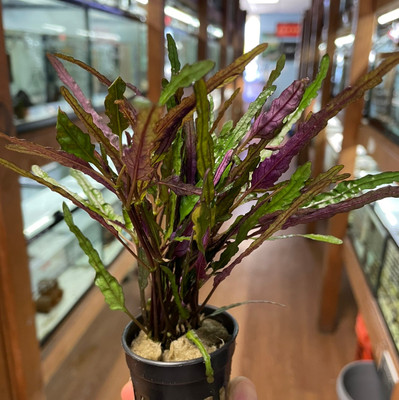Hemigraphis repanda (Dragon’s Tongue)
Posted by Max Gandara on on 18th May 2025
Hemigraphis repanda (Dragon’s Tongue): A Bold Touch of Texture for Aquascapes
If you're looking to add a splash of unusual texture and a mystical, almost fantasy-like vibe to your aquarium, Hemigraphis repanda—commonly called Dragon’s Tongue—might just be your new favorite plant. With its serrated, lance-shaped leaves and striking coloration, it’s a standout addition that brings personality to any scape.
But before adding this plant to your tank, it’s important to know the full story: Hemigraphis repanda is often sold as an aquatic plant, but it's semi-aquatic or terrestrial in nature, and requires specific conditions to thrive long-term underwater.
? Quick Plant Profile
| Attribute | Details |
|---|---|
| Common Name | Dragon’s Tongue |
| Scientific Name | Hemigraphis repanda |
| Type | Semi-aquatic (borderline terrestrial) |
| Position | Foreground to midground (short-term) |
| Light Needs | Medium to high |
| CO₂ | Not required (but helps) |
| Growth Rate | Slow (in submerged form) |
| Origin | Southeast Asia |
? Is Dragon’s Tongue Truly Aquatic?
This is where things get tricky. While Hemigraphis repanda is often sold as an aquarium plant, it’s not a true aquatic species. It can survive submerged for weeks or even a few months, especially in high-humidity or emersed setups (like paludariums), but in most cases:
-
Submerged leaves eventually melt or rot.
-
The plant weakens and dies without consistent emersed access.
So what’s the takeaway?
Use Hemigraphis repanda as a temporary accent in underwater aquascapes or as a long-term feature in paludariums and ripariums, where its roots are in water but the leaves are above the surface.
? Visual Appeal
-
Color: Deep green to purple-tinged leaves (color varies with lighting)
-
Texture: Long, jagged, wavy leaves resembling a dragon’s tongue (hence the name)
-
Height: 10–20 cm (4–8 inches)
Its dramatic texture contrasts beautifully with soft mosses or fine-leaved plants like Rotala or Myriophyllum, making it a perfect focal plant in artistic or fantasy-inspired layouts.
?️ How to Use It in Aquascaping
✅ Best for:
-
Paludariums
-
Ripariums
-
Wabi-kusa setups
-
Terrariums
-
Short-term use in freshwater aquariums (2–3 months max)
❌ Not ideal for:
-
Long-term underwater aquascapes
-
High-flow tanks or aggressive fish setups
?️ Care Tips
| Parameter | Ideal Range |
|---|---|
| Temperature | 22–28°C (72–82°F) |
| pH | 6.0–7.5 |
| Light | Moderate to high (brings out color) |
| Humidity | High (for emersed growth) |
| Substrate | Nutrient-rich or soil-based |
-
Lighting: Bright lighting enhances the purplish tones and leaf contrast.
-
Humidity: In paludariums, keep humidity above 70% for lush growth.
-
Submersion: If submerged, expect it to survive short-term but eventually decline.
✂️ Maintenance
-
Trim leggy or decaying leaves regularly.
-
Provide good airflow in enclosed terrariums to prevent mold.
-
Fertilize with root tabs or emersed foliar feeding (optional, but beneficial).
? Tankmates & Compatibility
If used temporarily in tanks:
✅ Works well with:
-
Bettas
-
Shrimp
-
Peaceful nano fish
-
Emersed setups with frogs or semi-aquatic reptiles
❌ Avoid:
-
Goldfish, large cichlids, or any herbivorous species
? Fun Facts
-
The name “Dragon’s Tongue” comes from its jagged, textured leaf edges.
-
Belongs to the same family (Acanthaceae) as popular houseplants like Fittonia and Hypoestes.
-
In nature, it grows along humid, shaded forest floors and riverbanks—often partially submerged.
✅ Conclusion: A Fantasy Plant for Artistic Aquascapes
Hemigraphis repanda (Dragon’s Tongue) isn’t your typical aquarium plant—but when used correctly, it adds an otherworldly touch to aquascapes and paludariums. Think of it as a plant for creative expression, temporary artistic impact, or long-term use in emersed environments.
If you’re looking to design a mystical aquascape, jungle-themed paludarium, or just experiment with something unique, Dragon’s Tongue is a bold, beautiful choice—just don’t expect it to thrive forever underwater.

